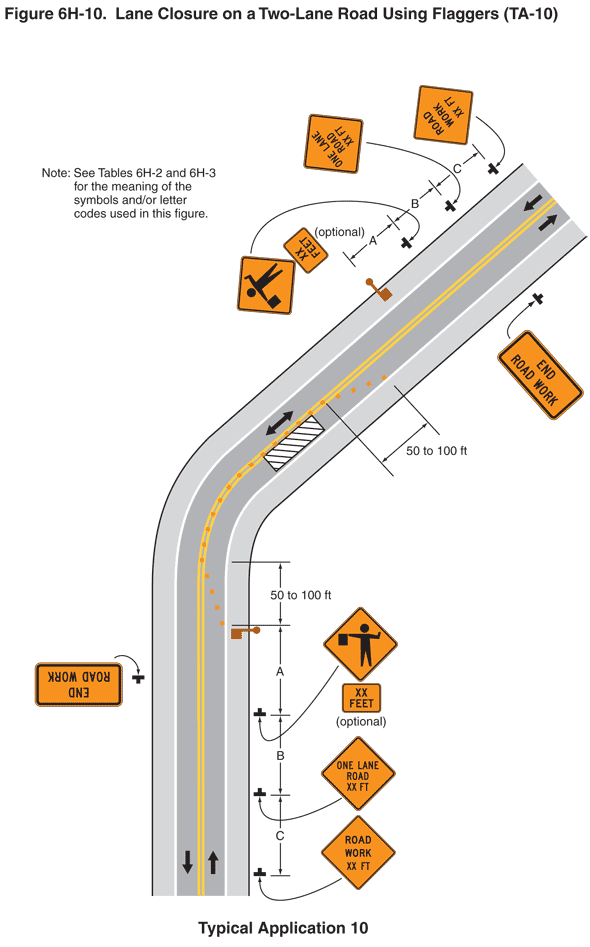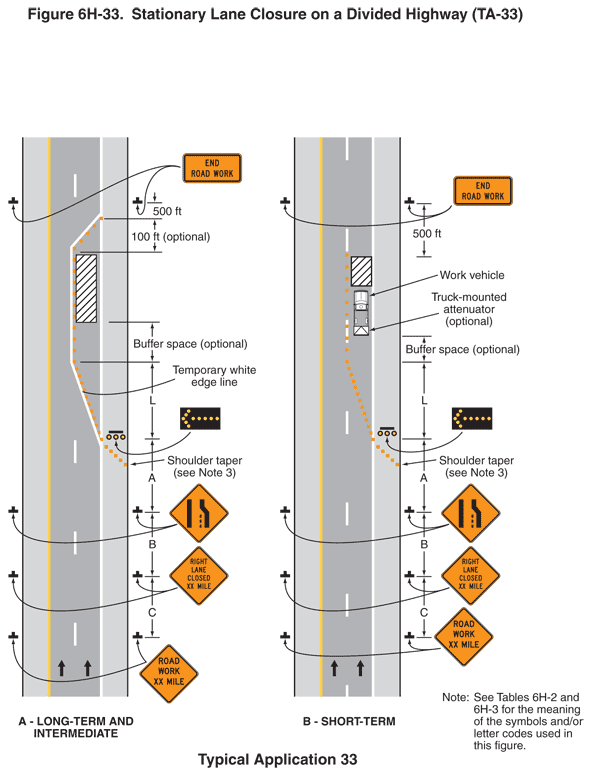Typical Application

Figure 6H-10. Lane Closure on a Two-Lane Road Using Flaggers (TA-10)
This figure illustrates lane closure on a two-lane road using flaggers. A legend under the figure states that this is Typical Application 10. A note states “See Tables 6H-2 and 6H-3 for the meaning of the symbols and/or letter codes used in this figure.”
A vertical two-lane roadway is shown, the top half curving to the right. Downward-pointing black arrows in the left lane and upward-pointing black arrows in the right lane denote the direction of travel. The opposing lanes are shown separated by a solid double yellow line. A shoulder is shown to the right of each direction of travel. The shoulders are shown separated from the travel lanes by a solid white line.
At the bottom of the figure and to the right of the shoulder of the right lane, a black inverted “T” is shown denoting a sign. The sign is shown as a diamond-shaped orange sign with a black border and the words “ROAD WORK XX FT” in black. This sign is shown at a dimensioned distance C in advance of another diamond-shaped orange sign with a black border to the right of the right shoulder. It shows the words “ONE LANE ROAD XX FT” in black. This sign is shown at a dimensioned distance B in advance of a sign assembly to the right of the right shoulder. This assembly is shown as composed of a diamond-shaped orange sign with a black border and a black symbol of a flagger above a horizontal rectangular orange supplemental plaque labeled optional with a black border and the distance “XX FEET” in black. This sign assembly is shown at a dimensioned distance A in advance of a red symbol for a flagger, shown on the right shoulder. Beginning where the flagger is shown and at the white line separating the shoulder from the right lane, a series of orange squares, denoting channelizing devices, are shown tapering in to the solid double yellow line separating the opposing traffic lanes. The space between the first channelizing device at the shoulder to the one shown on the solid double yellow line is shown as a dimension of 50 to 100 ft. Beyond this area, the channelizing devices continue along the solid double yellow line as the road is shown curving to the right.
Beyond the curve, the work space is shown in the right lane, represented by a vertical rectangular black and white diagonally striped box. The channelizing devices are shown continuing along the solid double yellow line to a point one device beyond the work space and then tapering back to the right shoulder for a dimensioned distance of 50 to 100 ft. Near the top of the figure, a horizontal rectangular orange sign with a black border is shown to the right of the right shoulder with the words “END ROAD WORK” in black.
At the top of the figure, to the outside of the left lane, the same three diamond-shaped orange signs are shown at the same dimensioned distances in advance of another flagger symbol in advance of the work space. Beyond the work space and roadway curve in the left lane, another End Road Work sign is shown.

Figure 6H-33. Stationary Lane Closure on a Divided Highway (TA-33)
This figure illustrates two examples of stationary lane closure on a divided highway. A legend under the figure states that this is Typical Application 33. A note states “See Tables 6H-2 and 6H-3 for the meaning of the symbols and/or letter codes used in this figure.”
This figure shows two vertical examples of the two northbound lanes of a four-lane divided highway. Upward-pointing black arrows in the lanes denote the direction of traffic. A shoulder is shown to the left and right of each example. The shoulders are shown separated from the right lanes by a solid white line and from the left lanes by a solid yellow line. The two lanes in each example are shown separated from each other by a broken white line.
The first example is identified at the bottom of the figure as “A – LONG-TERM AND INTERMEDIATE.” At the bottom of the figure and to the outside of both the left and right shoulders, a black inverted “T” is shown denoting a sign. The sign is shown as a diamond-shaped orange sign with a black border and the words “ROAD WORK XX MILE” in black. Beyond the sign, at a dimensioned distance C, another sign is shown to the outside of both shoulders. It is shown as a diamond-shaped orange sign with a black border and the words “RIGHT LANE CLOSED XX MILE” in black. Beyond this sign, at a dimensioned distance B, another sign is shown to the outside of both shoulders. It shows a thick, vertical straight line on the left; a thick, vertical line on the right that angles toward the left half way up; and a thin, short vertical dotted line between them that is the length of the vertical section of the line on the right, denoting a lane ends. Beyond this sign, a series of orange squares, denoting channelizing devices, is shown beginning at the far right edge of the right shoulder and tapering to the left to the white line separating the shoulder from the right lane. A leader arrow to a note states “Shoulder taper (see Note 3).” At the end of the shoulder taper, a horizontal rectangular black arrow panel with a yellow directional arrow pointing to the left is shown across the right shoulder. The arrow panel is shown at a dimensioned distance A from the lane ends symbol sign.
At this point, a series of channelizing devices is shown continuing to taper to the left to the broken white line for a dimensioned distance L. Just to the left of the devices for the length of the taper, a solid temporary white edge line is shown. The channelizing devices then are shown continuing straight along the broken white line through an undimensioned buffer space labeled optional. Just to the left of the channelizing devices, a temporary solid white edge line is shown on the pavement for the same distance. At the end of the buffer space, a vertical rectangle with black and white diagonal stripes is shown, denoting a work space. The channelizing devices are shown continuing along the left side of the work space adjacent to the temporary white edge line. Beyond the work space, the devices are shown beginning to taper to the right again and continuing to the solid white line separating the right lane from the shoulder for a dimensioned distance of 100 ft labeled optional. The temporary white edge line is shown just to the left of the devices as they continue past the work space and then taper to the right. Beyond the end of the taper at a dimensioned distance of 500 ft and to the outside of both shoulders, a horizontal rectangular orange sign with a black border is shown with the words “END ROAD WORK” in black.
The second example is identified at the bottom of the figure as “B – SHORT-TERM.” At the bottom of the figure and to the outside of both the left and right shoulders, a black inverted “T” is shown denoting a sign. The sign is shown as a Road Work XX Mile sign. Beyond the sign, at a dimensioned distance C, another sign is shown to the outside of both shoulders. It is shown as a Right Lane Closed XX Mile sign. Beyond this sign, at a dimensioned distance B, another sign is shown to outside of both shoulders. The sign is shown as a lane ends symbol sign with the right lane tapering to the left. Beyond this sign, a series of channelizing devices is shown beginning at the far right edge of the right shoulder and tapering to the left to the white line separating the shoulder from the right lane. A leader arrow to a note states “Shoulder taper (see Note 3).” At the end of the shoulder taper, a horizontal rectangular black arrow panel with a yellow directional arrow pointing to the left is shown across the right shoulder. The arrow panel is shown as a dimensioned distance A from the lane ends symbol sign.
At this point, a series of channelizing devices is shown continuing to taper to the left to the broken white line for a dimensioned distance L. The channelizing devices then are shown continuing straight along the broken white line through an undimensioned buffer space labeled optional. At the end of the buffer space, a work vehicle with a truck-mounted attenuator labeled optional is shown in advance of a work space. The channelizing devices are shown continuing and ending at the end of the work space. Beyond the work space, at a dimensioned distance of 500 ft, an End Road Work sign is shown to the outside of both shoulders.